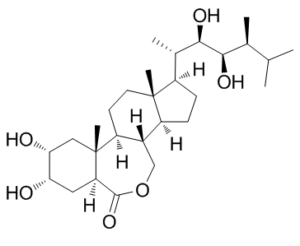Brassinolide
This product is for research use only, not for human use. We do not sell to patients.

For small sizes, please check our retail website as below: www.invivochem.com
| Size | Price | Stock |
|---|---|---|
| 250mg | $750 | Check With Us |
| 500mg | $1250 | Check With Us |
| 1g | $1875 | Check With Us |
Cat #: V3417 CAS #: 72962-43-7 Purity ≥ 98%
Description: Brassinolide, a plant growth modulator and a plant hormone, is a sterol compound first isolated from pollen of rape (Brassica napus L.).
Top Publications Citing Invivochem Products
Publications Citing InvivoChem Products
Product Promise

- Physicochemical and Storage Information
- Protocol
- Related Biological Data
- Stock Solution Preparation
- Quality Control Documentation
| Molecular Weight (MW) | 480.68 |
|---|---|
| Molecular Formula | C28H48O6 |
| CAS No. | 72962-43-7 |
| Storage | -20℃ for 3 years in powder formr |
| -80℃ for 2 years in solvent | |
| Solubility In Vitro | DMSO: ≥ 5 mg/mLr |
| SMILES Code | O[C@H]1[C@@H](O)C[C@@](C(OC[C@]2([H])[C@]3([H])CC[C@@]4(C)[C@]2(CC[C@]4([H])[C@H](C)[C@@H](O)[C@H](O)[C@H](C(C)C)C)[H])=O)([H])[C@]3(C)C1 |
| Synonyms | 2,3,22,23-Tetrahydroxy-β-homo-7-oxaergostan-6-one |
| Protocol | In Vitro | Brassinolide is a plant sterol first isolated from pollen of rape (Brassica napus L.). Brassinolide can induce a time and concentration-dependent cytotoxicity in PC-3 cells. The mode of cell death appears to be predominately apoptosis, as shown by flow-cytometric analysis, fluorescence and transmission electron microscopes. Caspase-3 activity is obviously increased after Brassinolide treatment. Western blot studies indicate that treatment with Brassinolide triggered a time-dependent decrease in the expression of anti-apoptotic protein Bcl-2, which suggests that Brassinolide can induce cytotoxicity in PC-3 cells by triggering apoptosis. Brassinolide might therefore be a promising candidate for the treatment of prostate cancer. |
|---|
These protocols are for reference only. InvivoChem does not
independently validate these methods.
| Solvent volume to be added | Mass (the weight of a compound) | |||
|---|---|---|---|---|
| Mother liquor concentration | 1mg | 5mg | 10mg | 20mg |
| 1mM | 2.0804 mL | 10.4019 mL | 20.8039 mL | 41.6077 mL |
| 5mM | 0.4161 mL | 2.0804 mL | 4.1608 mL | 8.3215 mL |
| 10mM | 0.2080 mL | 1.0402 mL | 2.0804 mL | 4.1608 mL |
| 20mM | 0.1040 mL | 0.5201 mL | 1.0402 mL | 2.0804 mL |
The molarity calculator equation
Mass(g) = Concentration(mol/L) × Volume(L) × Molecular Weight(g/mol)
Mass
=
Concentration
×
Volume
×
Molecular Weight*
The dilution calculator equation
Concentration(start)
×
Volume(start)
=
Concentration(final)
×
Volume(final)
This equation is commonly abbreviated as: C1 V1 = C2 V2
Concentration(start)
C1
×
Volume(start)
V1
=
Concentration(final)
C2
×
Volume(final)
V2
Step One: Enter information below
Dosage mg/kg
Average weight of animals g
Dosing volume per animal µL
Number of animals
Step Two: Enter the in vivo formulation
%DMSO
+
%
+
%Tween 80
+
%ddH2O
Calculation Results:
Working concentration:
mg/ml;
Method for preparing DMSO master liquid:
mg
drug pre-dissolved in
µL
DMSO(Master liquid concentration
mg/mL)
,Please contact us first if the concentration exceeds the DMSO solubility of the batch of drug.
Method for preparing in vivo formulation:
Take
µL
DMSO master liquid, next add
µL
PEG300, mix and clarify, next add
µL
Tween 80,mix and clarify, next add
µL
ddH2O,mix and clarify.
Note:
- (1) Please be sure that the solution is clear before the addition of next solvent. Dissolution methods like vortex, ultrasound or warming and heat may be used to aid dissolving.
- (2) Be sure to add the solvent(s) in order.




































